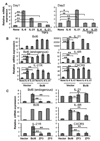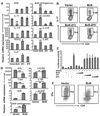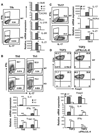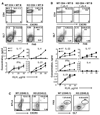Bcl6 mediates the development of T follicular helper cells
- PMID: 19628815
- PMCID: PMC2857334
- DOI: 10.1126/science.1176676
Bcl6 mediates the development of T follicular helper cells
Abstract
A fundamental function of CD4+ helper T (T(H)) cells is the regulation of B cell-mediated humoral immunity. Development of T follicular helper (T(FH)) cells that provide help to B cells is mediated by the cytokines interleukin-6 and interleukin-21 but is independent of TH1, TH2, and TH17 effector cell lineages. Here, we characterize the function of Bcl6, a transcription factor selectively expressed in T(FH) cells. Bcl6 expression is regulated by interleukin-6 and interleukin-21. Bcl6 overexpression induced T(FH)-related gene expression and inhibited other T(H) lineage cell differentiation in a DNA binding-dependent manner. Moreover, Bcl6 deficiency in T cells resulted in impaired T(FH) cell development and germinal center reactions, and altered production of other effector T cell subsets. Our data thus illustrate that Bcl6 is required for programming of T(FH) cell generation.
Figures




Comment in
-
Immunology. The yin and yang of follicular helper T cells.Science. 2009 Aug 21;325(5943):953-5. doi: 10.1126/science.1178752. Science. 2009. PMID: 19696339 No abstract available.
References
Publication types
MeSH terms
Substances
Grants and funding
LinkOut - more resources
Full Text Sources
Other Literature Sources
Molecular Biology Databases
Research Materials
Miscellaneous

